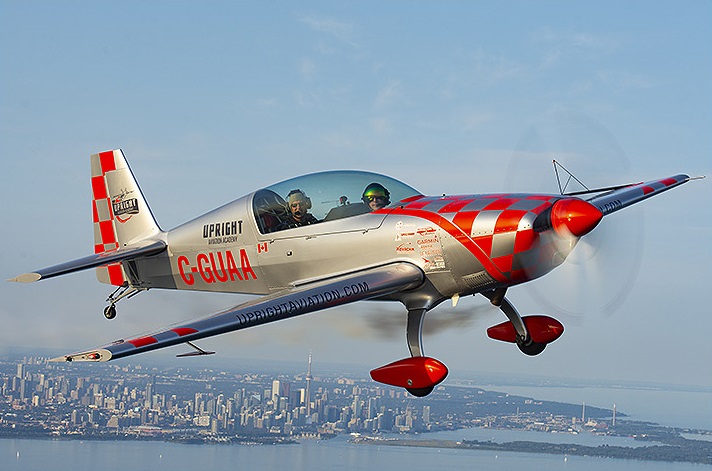Estimated reading time 6 minutes, 54 seconds.
The Upright Aviation Academy, based at Burlington Executive Airport, recently opened its doors and offers a wide range of services. The company offers upset prevention and recovery training (UPRT), emergency manoeuvre training and pilot confidence courses for all levels of pilots. For non-pilots, it offers aerobatic thrill rides and scenic flights using the company’s Extra 300L aircraft.

“The company was created to enhance pilot training and safety. Loss of control accidents are the main causes of aviation fatalities and UAA’s trained instructors follow upset prevention and recovery training industry standard concepts and guidelines. The objective is to help pilots and flight crews acquire the attitude and skills needed to prevent or recover from developed or developing upset flight,” stated Geoff Armstrong, Upright Aviation Academy’s founder.
UPRT originated with a study by the Royal Aeronautical Society in 2009 to address the growing issue of loss of control (LOC-I) accidents resulting in fatalities. The goal for the assembled professionals was to establish industry standard guidelines to improve aviation standards. In 2011, the FAA commissioned a committee to develop UPRT methodologies. In 2012, the European Aviation Safety Agency (EASA) joined efforts with the FAA and the International Civil Aviation Organization (ICAO) to create an acceptable approach to reduce LOC-I events, now known as the loss of control avoidance and recovery training (LOCART) initiative. ICAO document 10011 describes the importance of awareness, prevention and significance of learning recovery techniques.
Upright Aviation Academy believes in a hands-on approach and currently uses an Extra 300L aircraft for its training. The ground portion of the program focuses on how to avoid loss of control. In aircraft training, the pilots are taught how to properly stop flight path divergence. An upset is described as a nose pitch up more than 25 degrees, nose down pitch of 10 degrees or bank angle exceeding 45 degrees or flying at speeds inappropriate for those conditions. Statistics show airlines are at just as much risk of LOC-I events as general aviation pilots.

“We show the customer how and why pilots lose control, and the mitigation techniques to avoid and if encountered, to recover. We can reduce these risks through skills and knowledge — being aware of the situations, risks and threats in specific targeted training. Our current pilot training formats are excellent in Canada, but there is something missing and we need to implement this training to fill those gaps. If we’re doing our training and pilot certification correctly, and evaluating pilots’ skills, knowledge and ability correctly, why do we have so many loss of control accidents? We do focus on recovery in the aircraft, but our ground programs mainly focus on avoidance techniques. Nearly 90 per cent of the attitude envelope is not addressed in flight training. If a pilot gets into that region, they have the potential to make the situation worse,” explained Armstrong. The consensus these days is that many professional pilots lack good hand and feet skills.
One of the main reasons the Extra 300L was chosen is because there are no prohibited manoeuvres and it is the globally preferred and recognized aircraft for UPRT training. With a 3,000 foot per-minute climb rate it performs like a jet — add to that a great field of vision and a +10/-10 G limit. The lessons learned in aerobatic aircraft are transferable to any aircraft as fundamentals of aircraft control are taught before the trainee moves onto instrument and simulator recovery techniques. That being said, simulators cannot create the physical aspects of a LOC-I event and this is why there is a necessity of a piston aerobatic aircraft — the trainee can make a mistake in the aircraft and not break or over stress the airplane.
“We plan on pairing in-aircraft training with simulators for the transfer of skill for UPRT techniques to mitigate LOC-I accidents,” said Armstrong.
Upright Aviation Academy was founded by Geoff Armstrong who comes from an extensive aviation family. His background includes corporate, U.S. airline and charter flying and he was a chief pilot managing 65 pilots and 15 aircraft. Geoff created UAA’s training programs and completed Transport Canada’s requirements for issuance of the Flight Training Unit operating certificate. The company currently has three other instructors on its roster. Lyn Armstrong, a seasoned bush pilot who flew Beavers, Beech 18s and DC-3s currently holds 6 jet ratings and instructs airline pilots at a large simulator training company on the Boeing 737, and previously, 767 and 787 as well as CRJs. Recently added to the crew is Trevor Rafferty and Liam Pearson. Trevor is an experienced aerobatic competition and air show pilot, Liam is a Class 1 Aerobatic Instructor and current airline pilot.
“We offer our courses for any level of pilot and we cater the course based on experience, type of flying and type of aircraft operated by the customer. We also offer aerobatic training, aerobatic instructor ratings and thrill rides for pilots or people that want to learn, see and feel what it’s like to fly aerobatics with an airshow and competition pilot,” added Armstrong.
A special thanks to Kovachik Aircraft Service, Spectrum Airways and Lawrence Aero for sponsoring the photo flight for this article. Find out more about Upright Aviation Academy at www.uprightaviation.com.








